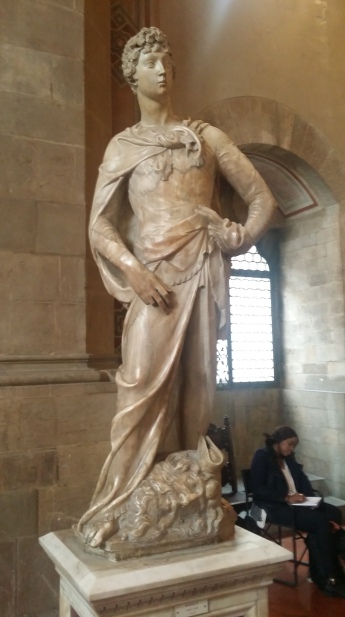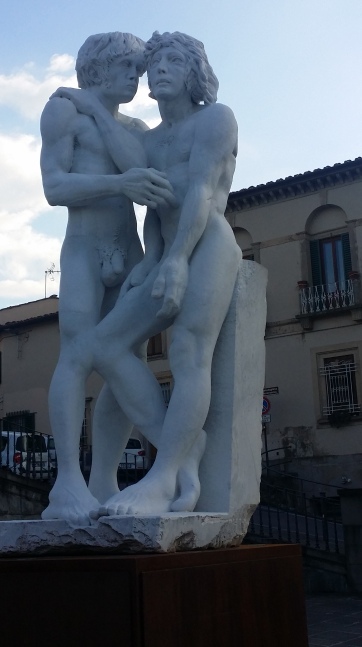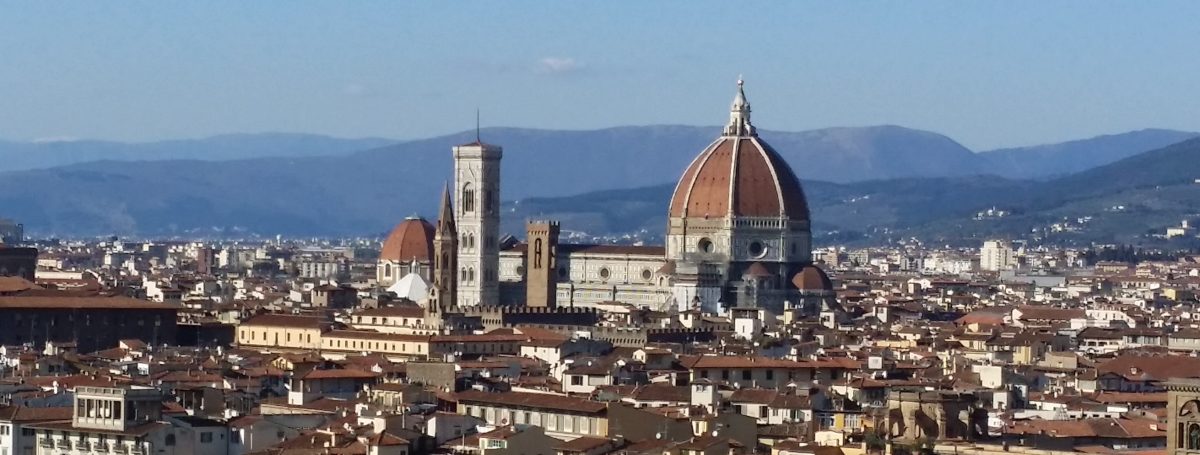How many statues of David are there in Florence? One wit said that there are probably thousands if you count all of the replicas of Michelangelo’s version that can be found in every souvenir stall in the city. That’s being too cute. But there is definitely more than one – in fact, there are five separate and original representations of the biblical hero made by the greatest sculptors of the Renaissance. So here’s a bit of a tour.
Let’s start with the big fella, Michelangelo Buonarotti’s extraordinarily evocative work that stands in the Accademia Gallery. This is obviously the most famous David in Florence, and probably the world, and it is still an incredibly popular attraction, despite its ubiquity. Like the Mona Lisa, we all have to stand in a crowd to see it. We thought we might be able to beat the crowd (and save a few Euros) by getting up early and walking across to the Accademia in time for its opening, on the first Sunday of the month, which is the day when every major gallery in Florence opens its doors for free. Well, we may have been a bit tardy, but we still got there at 8:30, but sure enough the queue was already half way down the street!
So what is it about this cliché of a work that gets Italians and tourists alike out of bed on a cold and wet Sunday morning? Of course, you know what its going to look like. Yet, even seen over the heads of the crowd as you approach, there is something different about it that none of the photographs ever quite capture, and that is its luminosity. The statue seems almost to glow with a purity that is not just a trick of the light. Close up, it is enormous, and the famous proportions really do work when viewed from below.
The other thing that is interesting to me, particularly in light of the other statues I’ll talk about in a moment, is that this is a particularly virile representation of David. He is shown as a strong, perfectly muscled young man (many a gym bunny would die for these pecs and abs), mature and confident. The expression on his face is one of intense concentration, although its not exactly clear whether the artist intended to represent David in the moments before or after his triumph over Goliath. But all in all, the statue conveys an image of physical prowess.
There are a couple of copies of this masterwork elsewhere in Florence; most famous is the copy that stands in front of the Palazzo Vecchio, the ancient seat of Florentine government, placed there after the original was removed to its present home. Grey and weather-stained, it doesn’t really come close to the original, even though it is a reasonably faithful copy. And then there is a bronze copy high up on the Piazzale Michelangelo, the viewing platform that overlooks the city – up here, the famous calm face seems to have an expression of distaste as it looks down on the legions of tacky souvenir sellers flogging plastic copies of himself by the hundred.
Back across town, the other three Davids all live in the Bargello museum. This is a fascinating building in itself, Florence’s first town hall, then the seat of justice, where the Podesta meted out judgements, and eventually one of the most feared prisons in the city. Its square, castle-like shape and high stone tower were the model for the nearby Palazzo Vecchio, which echos the design of this comparatively modest building, but on a grander scale. Today it houses what I think is one of the most enchanting and accessible museums in Florence, devoted almost entirely to Renaissance sculpture.
So, let’s have a look at the next most important (in my opinion anyway) statue of David in Florence. This is the one by Donato di Niccolo di Betto Bardi – better known as Donatello. To my mind, this statue is almost the complete antithesis of Michelangelo’s muscular stud.
Where Michelangelo gives us a mature man, Donatello’s David is clearly and obviously a youth, perhaps fifteen or sixteen, well muscled but unformed, coltish, gangling. The hat is of the type that a peasant might wear in Donatello’s own time, and combined with the long hair and the pose with hand on hip, the statue has a distinctly androgynous feel about it. Donatello gives us David in his moment of triumph, his booted foot on the slain giant’s head, yet the look on his face is rather sly. All in all, I think this is a rather fascinating and intriguing image.
The statue is important not just for its subject matter, but also for its technical and historical achievement, for this was the first life size male nude to have been cast since antiquity. It was commissioned by Cosimo de’ Medici in 1430, and when completed it stood in the courtyard of the Palazzo Medici, itself designed by Donatello’s business partner, Michelozzo Michelozzi, another of Cosimo’s favourite artists. Florence was such a small community back then.
Some forty years later, another great Florentine, Andrea del Verrochio, had another go at the subject of David.

Like Donatello, Verrochio represents the hero as a rather skinny youth (it has been suggested that the model might have been the young Leonardo Da Vinci, who spent some time in Verrochio’s bottega). This is unquestionably David triumphant, his foot firmly planted on Goliath’s head, which wears an expression of surprise as if astonished at the youth of his slayer. And unlike Donatello’s statue, this David is fully clothed!
So that’s three Davids. The other two are not quite as well known, nor as prominent – and one may not be David at all.
Our friend Donatello had in fact had a previous encounter with the biblical giant-slayer. Back in his early twenties, he had been commissioned to carve a statue to be placed on one of the buttresses of Florence’s great Cathedral of Santa Maria del Fiore. For various reasons it was never placed there, languishing in storage for a while before finally being placed in the Palazzo Vecchio.

There is probably not a lot to be said about this statue, for though it is beautiful in its own way, and it shows the promise of the future great sculptor, it is entirely conventional in style with its classically draped form and curiously blank face.
And so to our final David – and we are back with Michelangelo. Actually, it’s a bit of a cheat to include this statue, since it is unfinished and it is not certain that the figure it represents is David at all – the work is equally commonly referred to as being Apollo.

The confusion arises because Giorgio Vasari, the Renaissance artist and critic, said it represented Apollo taking an arrow from his quiver, whereas whoever catalogued the inventory of the art works of Grand Duke Cosimo I identified it as “David”. If it does indeed represent David, it is a much more melancholy and remorseful representation, quite different from the sculptor’s later and more famous work.
So there you are, five different representations of David in the one city, whose fascination with this particular biblical figure seems to have stemmed from its self-image as a small and weak republic facing the giants that surrounded it – Venice, Milan, the Kingdom of Naples, and the ever-present threat from France and Spain, both keen to control the fractious Italian peninsula.
The subject of David continues to resonate in modern Florence. On a recent visit to the hillside village (suburb, really) of Fiesole, we were startled to encounter in the town square this modern statue of David and Jonathan – explicitly homoerotic in character – by Filippo Dobrilla.

And, finally, let’s descend from the lofty pedestal of high art, and finish with the version of David most often seen in Venice – though not often in such glorious colour!




Love your documentation of the Davids, Tony. A colourful and entertaining read, with a bit of learning thrown in.
LikeLike
Thanks Em – planning to bring back a bulk pack of cobalt-blue Davids to give to everyone ….
LikeLike